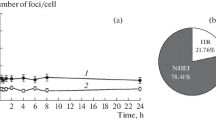Summary
The UV photoproduct, thymine dimer (\(\overline {TT} \)), is excorporated with a remarkably low rate from the DNA of human fibroblasts grown in cell culture. An UV dose of 18 J/m2 creates 0.045% \(\overline {TT} \) (related to thymine). Within the first two days of repair logarithmically growing and quiescent fibroblasts exhibit the same repair rates; thereafter, the proportion of \(\overline {TT} /T\) is lower in growing cells due to recovery of DNA replication. Only about 50% of the lesions are excised within 24 h. In quiescent cells, 13% of the thymine dimers originally present can be detected as late as a week after UV-irradiation. Two distinct first-order rate constants indicate that approximately half of the dimers are less accessible to repair. Repair measured by the nucleoid decondensation technique corresponds to the faster repair rate, whereas the slow repair rate cannot be detected by this method. Saturation of repair is found beyond 27 J/m2. The remarkably slow rate of excision indicates that thymine dimers are not lethal lesions in human fibroblasts.
Similar content being viewed by others
References
Amacher DE, Elliott JA, Lieberman MW (1977) Differences in removal of acetylaminofluorene and pyrimidine dimers from the DNA of cultured mammalian cells. Proc Natl Acad Sci USA 74:1553–1557
Cleaver JE (1979), Similar distributions of repaired sites in chromatin of normal and Xeroderma pigmentosum variant cells damaged by UV light. Biochim Biophys Acta 565:387–390
Cleaver JE, Trosko JE (1970) Absence of excision of ultraviolet-induced cyclobutane dimers in xeroderma pigmentosum. Photochem Photobiol 11:547–550
Cook PR, Brazell JA (1976a) Detection and repair of single-strand breaks in nuclear DNA. Nature 263:679–682
Cook PR, Brazell JA (1976b) Conformational constraints in nuclear DNA. J Cell Sci 22:287–302
Cook PR, Brazell JA, Jost E (1976) Characterization of nuclear structures containing superhelical, DNA. J Cell Sci 22:303–324
Ehmann UK, Cook KH, Friedberg EC (1978) The kinetics of thymine dimer excision in ultraviolet-irradiated human cells. Biophys J 22:249–264
Hatanaka M, Giuice R, Long C (1975) Adenin formation from adenosine by mycoplasmas adenosine phosphorylase activity. Proc Natl Acad Sci USA 72:1401–1405
Herrlich P, Rahmsdorf HJ, Pai SH, Schweiger M (1974) Translational control induced by bacteriophage T7. Proc Natl Acad Sci USA 71:1088–1092
Kantor GJ, Setlow RB (1981) Rate and extent of DNA repair in nondividing human diploid fibroblasts. Cancer Res 41:819–825
Klocker H, Auer B, Burtscher HJ, Hofmann J, Hirsch-Kauffmann M, Schweiger M (1982) A sensitive radioimmuno assay for thymine dimers. Mol Gen Genet 186:475–477
Lawrence CW (1981) Are pyrimidine dimers non-instructive lesions? Mol Gen Genet 182:511–513
Paterson MC, Lohman HM, Sluyter ML (1973) Use of a UV endonuclease from micrococcus luteus to monitor the progress of DNA repair in UV-irradiated human cells. Mutat Res 19:245–256
Regan JD, Trosko JE, Carrier WL (1968) Evidence for excision of ultraviolet-induced pyrimidine dimers from the DNA of human cells in vitro. Biophys J 8:319–325
Sauerbier W, Hirsch-Kauffmann M (1968) Transfer of ultraviolet light induced thymine dimer from parental to progeny DNA in bacteriophage T1 and T4. Biochem Biophys Res Commun 33:32–37
Sauerbier W, Millette RL, Hackett PB Jr (1970) The effects of ultraviolet irradiation on the transcription of T4 DNA. Biochim Biophys Acta 209:368–386
Sheinin R, Humbert J, Pearlman RE (1978) Some aspects of eukaryotic DNA replication. Annu Rev Biochem 47:277–316
Smerdon MJ, Lieberman MW (1978) Nucleosome rearrangement in human chromatin during UV-induced DNA repair synthesis. Proc Natl Acad Sci USA 75:4238–4241
Schwaiger H, Hirsch-Kauffmann M, Schweiger M (1982) UV-repair is impaired in fibroblasts from patients with Fanconi's anemia. Mol Gen Genet 185:454–456
Uitendaal MP, dBruyn CHM, Hatanaka M, Hösli P (1978) An ultramicrochemical test for mycoplasma contamination of cultured cells. In: Studies of purin metabolism in cultured human fibroblasts. University of Nijmegen, pp 73–82
Weniger P (1979) An improved method to detect small amounts of radiation damage in DNA of eukaryotic cells. Int J Rad Biol 36:197–199
Yew FFH, Johnson RT (1978) Human B and T lymphocytes differ in UV-induced repair capacity. Exp Cell Res 113:227–231
Author information
Authors and Affiliations
Additional information
Communicated by K. Illmensee
Rights and permissions
About this article
Cite this article
Klocker, H., Auer, B., Burtscher, H.J. et al. Repair rate in human fibroblasts measured by thymine dimer excorporation. Mol Gen Genet 188, 309–312 (1982). https://doi.org/10.1007/BF00332693
Received:
Issue Date:
DOI: https://doi.org/10.1007/BF00332693




